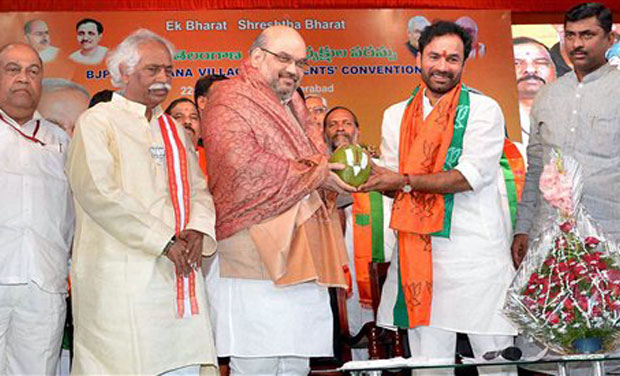Gone are the days when BJP’s influence and stronghold was only said to exist over the Hindi heartland states. If this election has proven anything, it is BJP’s ability to maintain their 2014 hold over the Hindi speaking states and successfully expand to others, where regional parties have dominated traditionally. Their unprecedented increase from 1 to 4 seats in Telangana, despite the presence of regional TRS has been one of the major indications to this. BJP’s performance in Telangana cannot be dismissed as mere ‘fluke’, as one opposition leader has claimed. It was a result of a brilliant strategy and flawless execution.
BJP’s electoral gains in Telangana have been a result of a well formulated electoral playbook. The outcome of this brilliant electoral strategy has been first hand witnessed in the state of West Bengal during these elections. The BJP has increased its tally from 2 seats to 18 in the traditional TMC dominated state.
In non-BJP strongholds, the party first seems to work on a simple and yet effective objective. The objective is to become the main opposition party.
In West Bengal, this is exactly what BJP had done during the Panchayat elections. By completely wiping out the left influence from the state’s politics, the saffron party had established itself as the main opposition in the state. Despite massive booth capturing and political violence at the hands of TMC, BJP had emerged as the direct competitor of TMC and thus had alerted the ruling TMC that their hold would be further deteriorated in the national elections to come.
However, in order to become the main opposition, the party had to cross a few hurdles. BJP had achieved this through a two-pronged strategy. The first step of this strategy was to strengthen the booth level organization. The second step was to attract influential local leaders from other parties.
BJP had worked from the grassroots level in West Bengal during the past 1 and a half years. There hadn’t been a single day wherein a major BJP leader wasn’t present in the state. Moreover, a hoard of TMC leaders including Mukul Roy, Subhrangshu Roy, Monirul Islam and Devjani Dasgupta , along with their cadre had joined BJP ahead of the Lok Sabha elections which had attracted a lot of support and popularity for BJP. Mamata Banerjee’s reign of terror provided the necessary push for the leaders to seek new affiliations.
Now it seems a similar strategy is at play in Telangana as well, aimed at dethroning TRS in the Vidhan Sabha elections to be held in 2023. In a very short time, BJP has established itself as the grassroots level and has replaced Congress as the main opposition party in the state. The strengthening of the booth level organization has been evident from the Lok Sabha results. Besides that, it is not just 4 seats that have been won from the state; it is what the seats represent. Dethroning KCR’s daughter, Kalvakuntla Kavitha, from her Nizamabad constituency had been the highlight of the elections in the state, even when she had done everything in her power to retain the seat. BJP’s second scalp in the state was Karimnagar, which used to be KCR’s seat during his days in Lok Sabha. Highly confident of TRS’ victory in the constituency, KCR had declared Karimnagar candidate B Vinod Kumar, a possible Union Minister in case the Federal Front came to power. In Adilabad, the third BJP victory, all the seven assembly segments in the constituency belonged to TRS and yet they suffered a massive loss, coming third. Secunderabad, the 4th seat in which BJP had performed outstandingly well, had been won by BJP in 2014 and the party had been sure to retain it. In fact, one of the factors which had led to this mandate was BJP’s emphasis on establishing themselves in other states and constituencies along with securing their previous strongholds.
Apart from this, several prominent Telangana leaders from Congress and TRS have defected from their parties and joined the BJP. Among the senior faces, Soyam Bapu Rao, a Congress dissident who had entered the BJP fray ahead of the elections, had won the party the Adilabad seat. Apart from him, Congress leaders including Ananda Bhaskar Rapolu, D K Aruna and Ponguleti Sudhakar Reddy had also joined the saffron party. Apart from Congress, even TRS leaders including A P Jithender Reddy had joined the BJP ahead of the elections. These leaders had increased BJP’s popularity amongst the people and has brought along their support base as well.
If the Bengal results are indicative of the success of BJP’s electoral playbook, TRS has a lot to worry about. Just as the saffron has come out victorious in Bengal, Telangana’s 4 seats are proof to BJP’s success in replicating the Bengal model. As the established precedence conveys, the regional parties in the country consider themselves to be invincible and are overly confident of their hold on their respective states. BJP has proven that they cannot take their dominance for granted. Ultimately, it is the electorate which has the power which is swayed towards the party promising development and welfare in the state.
